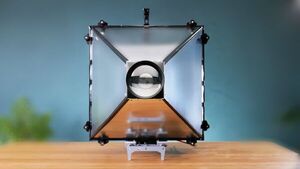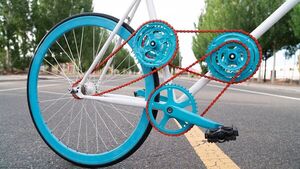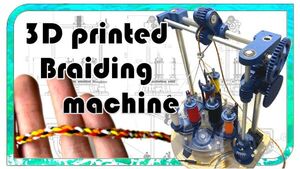2022-08-04 - Nº 379
Editorial
Esta é a Newsletter Nº 379 que se apresenta com o mesmo formato que as anteriores. Se gostar da Newsletter partilhe-a!
Todas as Newsletters encontram-se indexadas no link.
Esta Newsletter tem os seguintes tópicos:
Faz hoje anos que nascia, em 1755, o inventor francês Nicolas-Jacques Conté. Ele concebeu um método de fabrico de lápis de grafite, misturando uma grafite finamente pulverizada com partículas de argila finamente moídas, cozida, e utilizada envolta em madeira. A sua inovação foi desencadeada quando os fornecimentos de plumbago importados foram perturbados pela guerra. Foi o primeiro a utilizar grafite - e esta ainda hoje é utilizada como base para fabricar pontas de lápis. A utilização de diferentes proporções de argila para grafite varia a dureza da ponta do lápis. Foi encomendado por Napoleão como chefe do corpo de balões no Egipto, onde inventou formas de improvisar ferramentas e máquinas necessárias para fornecer pão, tecido, munições, instrumentos cirúrgicos e ferramentas dos engenheiros. Quando jovem, trabalhou como pintor de retratos.
Faz também hoje anos que nascia, em 1805, o matemático irlandês William Rowan Hamilton. Aos 12 anos de idade, Hamilton já tinha aprendido catorze línguas quando conheceu o americano, Zerah Colburn, que conseguia realizar façanhas mentais aritméticas espantosas, e eles juntaram-se em concursos. Parece que perder para Colburn despertou o interesse de Hamilton pela matemática. Aos 15 anos, ele começou a estudar as obras de LaPlace e Newton, pelo que aos 17 se tinha tornado o maior matemático vivo. Ele contribuiu para o desenvolvimento da óptica, da dinâmica e da álgebra. A sua invenção do cálculo de quaterniões permitiu uma álgebra ou geometria tridimensional que forneceu uma base para o desenvolvimento posterior da mecânica quântica.
Por fim, faz hoje anos que nascia, em 1834, o matemático e lógico inglês John Venn. Ele ficou conhecido por introduzir diagramas Venn, que são usados em lógica, teoria de conjuntos, probabilidade, estatística, e informática. Em 1866, Venn publicou The Logic of Chance, um livro pioneiro que defendia a teoria da frequência da probabilidade, argumentando que a probabilidade deveria ser determinada pela frequência com que algo é previsto, em oposição a suposições "educadas". Venn desenvolveu então as teorias de George Boole na obra Symbolic Logic de 1881, onde destacou o que ficaria conhecido como diagramas de Venn.
Em 1921, um fac-símile foi transmitido por rádio através do Oceano Atlântico utilizando o Belinógrafo inventado por Eduard Belin. Uma mensagem escrita do director do New York Times foi digitalizada pelo equipamento e enviada por rádio de Annapolis, Md., no espaço de sete minutos para os laboratórios de Belin em La Malmaison, França. A imagem recebida demonstrou que depois disso as fotografias podiam ser digitalizadas para transmissão via rádio da mesma forma. O método já estava a ser utilizado na Europa, enviando fotografias por fio. O original, envolto num cilindro rotativo, era digitalizado por um feixe de luz reflectido numa célula fotográfica para converter as variações na intensidade recebida em sinais eléctricos enviados por fios de rádio ou telefone.
Em 1954, o primeiro avião de combate supersónico britânico, o P-1 English Electric Lightning, fez o seu voo inaugural.
Na Newsletter desta semana apresentamos diversas noticias, artigos científicos, projetos de maker e alguns vídeos interessantes.
 João Alves ([email protected])
João Alves ([email protected])
O conteúdo da Newsletter encontra-se sob a licença  Creative Commons Attribution-NonCommercial-ShareAlike 4.0 International License.
Creative Commons Attribution-NonCommercial-ShareAlike 4.0 International License.
Novidades da Semana
Outras Notícias

Webb Captures Stellar Gymnastics in the Cartwheel Galaxy
"The space telescope’s powerful infrared gaze provides a new view of how the galaxy has changed over billions of years. NASA’s James Webb Space Telescope has peered into the chaos of the Cartwheel Galaxy, revealing new details about star formation and the galaxy’s central black hole. Webb’s powerful infrared gaze produced this detailed image of the Cartwheel and two smaller companion galaxies against a backdrop of many other galaxies. This image provides a new view of how the Cartwheel Galaxy has changed over billions of years. The Cartwheel Galaxy, located about 500 million light-years away in the Sculptor constellation, is a rare sight. Its appearance, much like that of the wheel of a wagon, is the result of an intense event – a high-speed collision between a large spiral galaxy and a smaller galaxy not visible in this image." [...]

Ultra-low capacitance ESD protection diodes from Nexperia protect automotive data interfaces
"Nexperia, the expert in essential semiconductors, today announced an extension to its portfolio of extremely low clamping and ultra-low capacitance ESD protection diodes. This portfolio is designed to protect high-speed data lines such as USB 3.2, HDMI 2.0, LVDS, automotive A/V Monitors, displays and cameras. Additionally, this portfolio also aims to address the upcoming high-speed video-links as well as the OPEN Alliance MGbit ethernet applications. These latest product additions include PESD5V0C1BLS-Q and PESD5V0C1ULS-Q both as 2-pin single line devices with very compact DFN1006BD-2 package for optimized routing flexibility. In addition, PESD5V0C2UM and PESD5V0C2UM-Q are available as 3-pin devices for both differential lines in DFN1006-3. All variants come in leadless packages to improve electrical performance and signal integrity." [...]
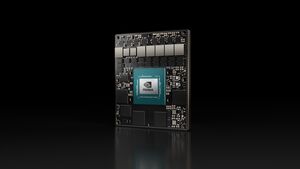
NVIDIA Jetson AGX Orin 32GB Production Modules Now Available; Partner Ecosystem Appliances and Servers Arrive
"Nearly three dozen partners are offering feature-packed systems based on the new Jetson Orin module to help customers accelerate AI and robotics deployments. Bringing new AI and robotics applications and products to market, or supporting existing ones, can be challenging for developers and enterprises. The NVIDIA Jetson AGX Orin 32GB production module — available now — is here to help. Nearly three dozen technology providers in the NVIDIA Partner Network worldwide are offering commercially available products powered by the new module, which provides up to a 6x performance leap over the previous generation. With a wide range of offerings from Jetson partners, developers can build and deploy feature-packed Orin-powered systems sporting cameras, sensors, software and connectivity suited for edge AI, robotics, AIoT and embedded applications. Production-ready systems with options for peripherals enable customers to tackle challenges in industries from manufacturing, retail and construction to agriculture, logistics, healthcare, smart cities, last-mile delivery and more." [...]

Microchip Introduces New CXL™ Smart Memory Controllers for Data Center Computing Enabling Modern CPUs to Optimize Application Workloads
"The SMC 2000 family of smart memory controllers delivers DDR memory bandwidth, capacity expansion, reliability and media flexibility for next-generation CPUs and SoCs to accelerate AI and machine learning performance. The continuous computational demands of Artificial Intelligence (AI) and Machine Learning (ML) workloads, cloud computing and data analytics deployed on traditional parallel attached memory have reached an efficiency plateau due to the limitations of increased memory channels on a processor. Microchip Technology Inc. (Nasdaq: MCHP) today announces the expansion of its serial-attached memory controller portfolio with the new SMC 2000 series of Compute Express Link™ (CXL™)-based Smart Memory Controllers that enable CPUs, GPUs and SoCs to utilize CXL interfaces to connect either DDR4 or DDR5 memory. This solution delivers more memory bandwidth per core, more memory capacity per core and lowers the overall Total Cost of Ownership (TCO) in the data center by allowing modern CPUs to optimize application workloads. The low-latency SMC 2000 16×32G and SMC 2000 8×32G memory controllers are designed to CXL 1.1 and CXL 2.0 specifications, DDR4 and DDR5 JEDEC standards and support PCIe® 5.0 specification speeds. The SMC 2000 16×32G is the industry’s highest-capacity controller with 16 lanes operating at 32 GT/s and it supports two channels of DDR4-3200 or DDR5-4800, resulting in a significant reduction in the required number of host CPU or SoC pins per memory channel." [...]

Renesas Launches 5V RX660 32-Bit MCUs with Superior Noise Tolerance for Home Appliances and Industrial Applications
"First RX Family MCUs with CAN FD Bus Protocol Enable High-Speed Communication for Industrial Equipment and Robotics Renesas Electronics Corporation (TSE:6723), a premier supplier of advanced semiconductor solutions, today announced a new addition to the RX 32-bit MCU Family, the RX660 group of microcontrollers (MCUs) that supports operating voltages of up to 5V, offering superior noise tolerance for home appliances and industrial equipment exposed to high electromagnetic interference. The RX660 is the first in Renesas’ higher-end RX general-purpose MCU devices to support 5V and the first in the RX Family to feature a built-in CAN FD controller that enables fast data communication. The high operating voltages of the new RX660 MCUs eliminate the need for external noise-suppression components that are required for many 3V MCUs today. This allows customer to reduce development time and component cost, improving system quality. In recent years, the scale of software has grown as functional safety and security have become a critical part of electronic systems. As the number of product models has also increased, more products are equipped with realtime operating systems in order to simplify software maintenance." [...]
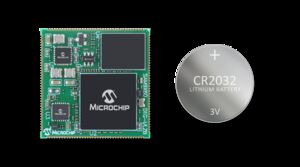
Microchip Expands Its Portfolio of MPU-Based System-on-Modules (SOMs) with the SAM9X60D1G-SOM
"The latest small-form factor SOM eases design and manufacturing and speeds time to market. As the embedded market continues to grow rapidly and evolve, developers are seeking to optimize product development, or they may need to transition from a microcontroller (MCU) to a microprocessor (MPU) to handle increased processing requirements. To help developers with this transition and reduce design complexities, Microchip Technology Inc. (Nasdaq: MCHP) today announces it has expanded its portfolio of MPU System-on-Modules (SOMs) with the SAM9X60D1G-SOM ARM926EJ-S™-based embedded MPU running up to 600 MHz. Software for the SAM9X60D1G-SOM is available with bare metal or RTOS support through MPLAB® Harmony 3 or complete Linux® mainlined distributions. The SOM, based on the SAM9X60D1G System in Package (SiP), is a small 28 mm × 28 mm hand-solderable module that includes the MPU and DDR in a single package, along with power supplies, clocks and memory storage. The SAM9X60D1G-SOM is Microchip’s first SOM equipped with 4 Gb SLC NAND Flash to maximize memory storage of data in application devices, while the on-board DDR reduces the supply and price risks associated with memory chips." [...]

Renesas Unveils Powerful 1GHz RZ/A3UL 64-Bit MPUs with RTOS Support That Enable High-Definition HMI and Quick Startup
"Versions Available Supporting High-Speed DDR3L/DDR4 Memory Interface and Octal-SPI Memory Interface for Simpler Design Renesas Electronics Corporation (TSE: 6723), a premier supplier of advanced semiconductor solutions, today announced the RZ/A3UL group of microprocessors (MPU) that enables both a high-definition human-machine interface (HMI) and quick startup for applications that require high throughput and real-time capabilities. The new RZ/A3UL allows customers to achieve the full potential of a real-time operating system (RTOS) while leveraging the performance boost provided by the 64-bit Arm® Cortex®-A55 CPU core with a maximum operating frequency of 1 GHz. Using an RTOS allows systems to start up instantly, in less than a second after boot-up. This feature is ideal for systems that require a fast response time such as industrial equipment, home appliances and office automation equipment with liquid crystal displays or control panels, as well as audio equipment and POS terminals. The new RZ/A3UL MPUs integrates an Octal-SPI memory interface*1 that facilitates simpler and more compact board designs. In addition, the new devices include versions that support a DDR3L/DDR4 memory interface to enable connection of high-speed DRAM." [...]

QCI Achieves a Quantum Landmark for BMW by Solving 3,854-Variable Problem in Six Minutes
"Quantum Computing Inc., a leader in accessible quantum computing, today announced that it has solved an optimization problem with over 3,800 variables in six minutes, delivering a superior and feasible solution. The Company achieved this landmark by applying a new quantum hardware technology called Entropy Quantum Computing (EQC) to the BMW Vehicle Sensor Placement challenge, a complex problem consisting of 3,854 variables and over 500 constraints. In comparison, today’s Noisy Intermediate Scale Quantum (NISQ) computers can process approximately 127 variables for a problem of similar complexity. The 2021 BMW Group and Amazon Web Services (AWS) Quantum Computing Challenge included a Vehicle Sensor Placement use case that challenged participants to find optimal configurations of sensors for a given vehicle that would provide maximum coverage (i.e. detect obstacles in different driving scenarios) at minimum cost. Although QCI placed as a 2021 finalist, its 2022 acquisition of quantum photonics systems company QPhoton provided a powerful suite of new quantum hardware technologies, including EQC." [...]

First Egyptian and Portuguese Astronauts to join Dude Perfect Cofounder on New Shepard’s 22nd Flight
"Blue Origin today announced its sixth human flight, NS-22, will lift off from Launch Site One on Thursday, August 4. The launch window opens at 8:30 AM CDT / 13:30 UTC. The webcast will start at T-30 minutes. Additionally, Blue Origin released the NS-22 mission patch. A few of the symbols embedded in the design include: - The Pyramids of Egypt represent Sara Sabry’s heritage and celebrate her accomplishment as the country’s first astronaut. - The Mariana Trench represents Vanessa O’Brien’s feat in reaching Challenger Deep, Earth’s deepest point." [...]
Ciência e Tecnologia
Super-Semiconductors
"Researchers report new material that could enable ultra-low-power electronic devices University of Delaware mechanical engineer Bingqing Wei and an international team of colleagues have discovered a promising new material they say could pave the way for ultra-low-power electronic devices. They call the material a super-semiconductor, a term based on two well-known words in electronics: superconductors and semiconductors. Superconductors are materials known since the early 1900s to conduct electricity with zero resistance at ultra-low temperatures, considered to range from -450 to -123 degrees Fahrenheit. Semiconductors are materials that exhibit both conductive and insulating properties, depending on temperature. Made from cobalt and aluminum, the super-semiconductor material is 3 to 10 times more conductive than typical semiconductor materials, such as silicon, at room temperature. It exhibits ultra-low resistivity, too, meaning it allows current to flow through the material with little resistance to slow the electricity down." [...]
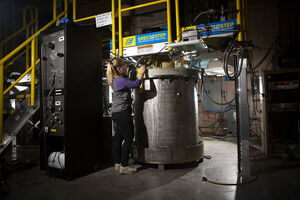
Research in MAGLAB verifies new phase of matter in material
"Strange behavior of ytterbium dodecaboride better understood. The three most-common phases of matter are well known: liquid, solid, gas. But under certain extreme conditions, matter exhibits much more bizarre behavior. Working with ytterbium dodecaboride (YbB12) under extreme conditions, a research team at the National High Magnetic Field Laboratory’s Pulsed Field Facility, or MAGLAB, in Los Alamos recently measured and identified unusual behavioral properties, especially in how the material can carry electrical charges, that reflect a new phase of matter. “The odd behavior of ytterbium dodecaboride has puzzled scientists in the field for several years,” said John Singleton, research team member. “Understanding the behavior better, we now realize that we’re looking at a new phase of matter.” Understanding strange behavior The compound YbB12 has unusual properties." [...]
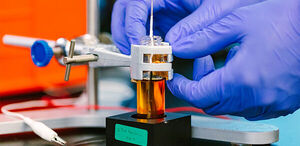
Molybdenum caught holding the hydrogen
"A transition metal catalyst discovery could help to establish renewably generated electricity at the heart of a clean chemicals industry. Sustainable fuel and chemicals production is closer to becoming a practical reality after KAUST researchers analyzed a precious metal-free electrochemical hydride transfer catalyst and discovered molybdenum was playing the central role. Platinum has long been the preferred catalyst for electrochemical hydride transfer, a versatile chemical process for producing valuable chemicals or carbon-free fuels. If this electrochemical process was powered with renewable electricity, it could enable a more sustainable society. Platinum, however, is a rare and expensive precious metal, placing significant limitations on the uptake of this technology. A far more abundant and less costly metal, molybdenum, could potentially take platinum’s place in the process, Magnus Rueping and his team have shown." [...]
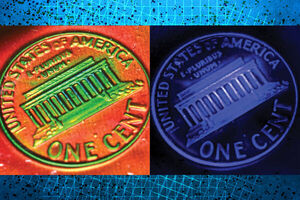
Engineers repurpose 19th-century photography technique to make stretchy, color-changing films
"The technique opens a door to manufacturing of pressure-monitoring bandages, shade-shifting fabrics, or touch-sensing robots. Imagine stretching a piece of film to reveal a hidden message. Or checking an arm band’s color to gauge muscle mass. Or sporting a swimsuit that changes hue as you do laps. Such chameleon-like, color-shifting materials could be on the horizon, thanks to a photographic technique that’s been resurrected and repurposed by MIT engineers. By applying a 19th-century color photography technique to modern holographic materials, an MIT team has printed large-scale images onto elastic materials that when stretched can transform their color, reflecting different wavelengths as the material is strained." [...]
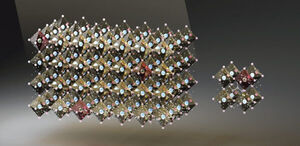
Getting more out of light
"Nanomaterials offer a way to get many electrical charges from each photon absorbed by a solar cell. Tiny crystals, known as quantum dots, have enabled an international team to achieve a quantum efficiency exceeding 100 percent in the photocurrent generated in a hybrid inorganic-organic semiconductor. Perovskites are exciting semiconductors for light-harvesting applications and have already shown some impressive performances in solar cells. But improvements in photo-conversion efficiency are necessary to take this technology to a broader market. Light comes in packets of energy known as photons. When a semiconductor absorbs a photon, the electromagnetic energy is transferred to a negatively charged electron and its positively charged counterpart, known as a hole." [...]
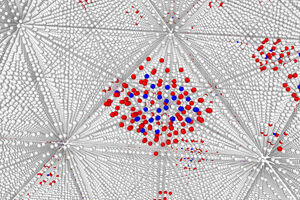
A better way to quantify radiation damage in materials
"More complete than existing methods, the new approach might enable longer operational lifetimes for nuclear reactors. It was just a piece of junk sitting in the back of a lab at the MIT Nuclear Reactor facility, ready to be disposed of. But it became the key to demonstrating a more comprehensive way of detecting atomic-level structural damage in materials — an approach that will aid the development of new materials, and could potentially support the ongoing operation of carbon-emission-free nuclear power plants, which would help alleviate global climate change. A tiny titanium nut that had been removed from inside the reactor was just the kind of material needed to prove that this new technique, developed at MIT and at other institutions, provides a way to probe defects created inside materials, including those that have been exposed to radiation, with five times greater sensitivity than existing methods. The new approach revealed that much of the damage that takes place inside reactors is at the atomic scale, and as a result is difficult to detect using existing methods. The technique provides a way to directly measure this damage through the way it changes with temperature." [...]

Researchers create the first artificial vision system for both land and water
"Inspired by a fiddler crab eye, scientists developed an amphibious artificial vision system with a panoramic visual field. Giving our hardware sight has empowered a host of applications in self-driving cars, object detection, and crop monitoring. But unlike animals, synthetic vision systems can’t simply evolve under natural habitats. Dynamic visual systems that can navigate both land and water, therefore, have yet to power our machines — leading researchers from MIT, the Gwangju Institute of Science and Technology (GIST), and Seoul National University in Korea to develop a novel artificial vision system that closely replicates the vision of the fiddler crab and is able to tackle both terrains. The semi-terrestrial species — known affectionately as the calling crab, as it appears to be beckoning with its huge claws — has amphibious imaging ability and an extremely wide field of view, as all current systems are limited to hemispherical. The new artificial eye, resembling a spherical, largely nondescript, small, black ball, makes meaning of its inputs through a mixture of materials that process and understand light." [...]
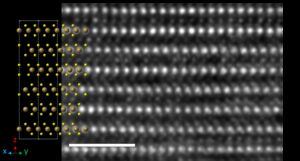
Manchester researchers make ‘significant advance’ in 2D material science with diversely behaving layers in a single bulk material
"Scientists from The University of Manchester have developed a novel yet simple method for producing vertical stacks of alternating superconductor and insulator layers of tantalum disulphide (TaS2). The findings, from a team led by Professor Rahul Nair, could speed up the process of manufacturing such devices – so-called van der Waals heterostructures – with application in high-mobility transistors, photovoltaics and optoelectronics. Van der Waals heterostructures are much sought after since they display many unique and useful properties not found in naturally occurring materials. In most cases, they are prepared by manually stacking one layer over the other in a time-consuming and labour-intensive process. Published last week in the journal Nano Letters, the study - led by researchers based at the National Graphene Institute (NGI) - describes synthesis of a bulk van der Waals heterostructure consisting of alternating atomic layers of 1T and 1H TaS2. 1T and 1H TaS2 are different polymorphs (materials with the same chemical composition but with a variation in atomic arrangement) of TaS2 with completely different properties – the former insulating, the latter superconducting at low temperatures." [...]

Smart lighting system based on quantum dots more accurately reproduces daylight
"Researchers have designed smart, colour-controllable white light devices from quantum dots – tiny semiconductors just a few billionths of a metre in size – which are more efficient and have better colour saturation than standard LEDs, and can dynamically reproduce daylight conditions in a single light. The researchers, from the University of Cambridge, designed the next-generation smart lighting system using a combination of nanotechnology, colour science, advanced computational methods, electronics and a unique fabrication process. The team found that by using more than the three primary lighting colours used in typical LEDs, they were able to reproduce daylight more accurately. Early tests of the new design showed excellent colour rendering, a wider operating range than current smart lighting technology, and wider spectrum of white light customisation. The results are reported in the journal Nature Communications. As the availability and characteristics of ambient light are connected with wellbeing, the widespread availability of smart lighting systems can have a positive effect on human health since these systems can respond to individual mood." [...]
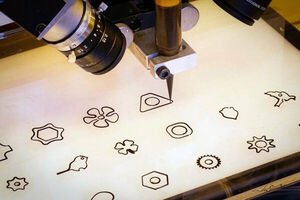
Using artificial intelligence to control digital manufacturing
"Researchers train a machine-learning model to monitor and adjust the 3D printing process to correct errors in real-time. Scientists and engineers are constantly developing new materials with unique properties that can be used for 3D printing, but figuring out how to print with these materials can be a complex, costly conundrum. Often, an expert operator must use manual trial-and-error — possibly making thousands of prints — to determine ideal parameters that consistently print a new material effectively. These parameters include printing speed and how much material the printer deposits. MIT researchers have now used artificial intelligence to streamline this procedure. They developed a machine-learning system that uses computer vision to watch the manufacturing process and then correct errors in how it handles the material in real-time." [...]

Computer modelling aims to inform restoration, conservation of coral reefs
"UBCO researcher creates hundreds of scenarios, determines importance of coral diversity. A UBC Okanagan research team has created a computer modelling program to help scientists predict the effect of climate damage and eventual restoration plans on coral reefs around the globe. This is a critical objective, says Dr. Bruno Carturan, because climate change is killing many coral species and can lead to the collapse of entire coral reef ecosystems. But, because they are so complex, it’s logistically challenging to study the impact of devastation and regeneration of coral reefs. Real-world experiments are impractical, as researchers would need to manipulate and disrupt large areas of reefs, along with coral colonies and herbivore populations, and then monitor the changes in structure and diversity over many years. “Needless to say, conducting experiments that will disturb natural coral reefs is unethical and should be avoided, while using big aquariums is simply unfeasible,” says Dr. Carturan, who recently completed his doctoral studies with the Irving K. Barber Faculty of Science." [...]

Solar is cheapest power, and a light-bulb moment showed we can cut costs further
"Expensive silicon has been used to produce the highest-efficiency solar panels. Now there’s a way to use cheaper raw materials. Recent extreme weather events have underscored the need to cut the CO₂ emissions that are driving up global temperatures. This requires a rapid transition of the energy economy to renewable energy sources, the cheapest being solar photovoltaics (PV). And our newly published research points to a way we can drive down costs of the shift even further using cheaper forms of silicon for highly efficient solar panels. Australia has been leading the way with solar PV installations, but our solar energy journey is just beginning." [...]
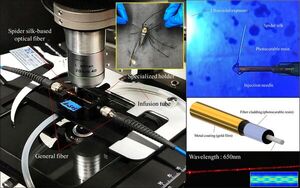
Researchers Create Biosensor by Turning Spider Silk into Optical Fiber
"New sensor can measure unknown sugar concentrations in real-time Researchers have harnessed the light-guiding properties of spider silk to develop a sensor that can detect and measure small changes in the refractive index of a biological solution, including glucose and other types of sugar solutions. The new light-based sensor might one day be useful for measuring blood sugar and other biochemical analytes. “Glucose sensors are crucial to people with diabetes, but these devices tend to be invasive, uncomfortable and not cost-efficient,” said research team leader Cheng-Yang Liu from National Yang Ming Chiao Tung University in Taiwan. “With spider silk attracting attention for its superior optomechanical properties, we wanted to explore using this biocompatible material to optically detect various sugar concentrations in real-time.” Liu and colleagues from Taiwan Instrument Research Institute and Taipei Medical University describe their new sensor in the Optica Publishing Group journal Biomedical Optics Express. They show that it can be used to determine concentrations of fructose, sucrose and glucose sugars based on changes in a solution’s refractive index. Spider silk is ideal for this application because it can not only transmit light like an optical fiber but is also very strong and elastic." [...]

New Chip-Based Beam Steering Device Lays Groundwork for Smaller, Cheaper Lidar
"Technology could benefit lidar applications from autonomous driving to virtual reality Researchers have developed a new chip-based beam steering technology that provides a promising route to small, cost-effective and high-performance lidar (or light detection and ranging) systems. Lidar, which uses laser pulses to acquire 3D information about a scene or object, is used in a wide range of applications such as autonomous driving, free-space optical communications, 3D holography, biomedical sensing and virtual reality. “Optical beam steering is a key technology for lidar systems, but conventional mechanical-based beam steering systems are bulky, expensive, sensitive to vibration and limited in speed,” said research team leader Hao Hu from the Technical University of Denmark. “Although devices known as chip-based optical phased arrays (OPAs) can quickly and precisely steer light in a non-mechanical way, so far, these devices have had poor beam quality and a field of view typically below 100 degrees.” In Optica, Optica Publishing Group’s journal for high-impact research, Hu and co-author Yong Liu describe their new chip-based OPA that solves many of the problems that have plagued OPAs. They show that the device can eliminate a key optical artifact known as aliasing, achieving beam steering over a large field of view while maintaining high beam quality, a combination that could greatly improve lidar systems. “We believe our results are groundbreaking in the field of optical beam steering,” said Hu." [...]
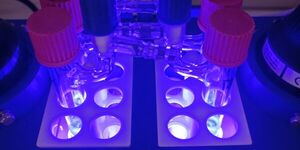
Light as a tool for the synthesis of complex molecules
"Chemists at the University of Münster present new method for β-amino acid derivatives from alkenes or (hetero)arenes Chemists at the University of Münster have developed a novel and straightforward way to produce complex organic molecules. Mild reaction conditions, simple operation, scalability and the use of an inexpensive and commercially available photosensitizer make the method interesting for industrial applications. The results of the study are currently (Aug. 1) published in Nature Chemistry. "Visible light has proven to be a powerful tool for the synthesis of complex organic molecules," explains Prof. Dr. Frank Glorius. "With its energy, we succeed in breaking certain chemical bonds X-Y." The resulting X and Y fragments are highly reactive, so-called "radicals."" [...]
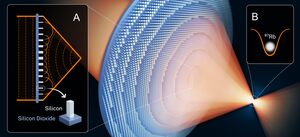
NIST Researchers Develop Miniature Lens for Trapping Atoms
"Nanopillar-studded surfaces interact with light to provide a new way to trap, image and manipulate single atoms. Atoms are notoriously difficult to control. They zigzag like fireflies, tunnel out of the strongest containers and jitter even at temperatures near absolute zero. Nonetheless, scientists need to trap and manipulate single atoms in order for quantum devices, such as atomic clocks or quantum computers, to operate properly. If individual atoms can be corralled and controlled in large arrays, they can serve as quantum bits, or qubits — tiny discrete units of information whose state or orientation may eventually be used to carry out calculations at speeds far greater than the fastest supercomputer. Researchers at the National Institute of Standards and Technology (NIST), together with collaborators from JILA — a joint institute of the University of Colorado and NIST in Boulder — have for the first time demonstrated that they can trap single atoms using a novel miniaturized version of “optical tweezers” — a system that grabs atoms using a laser beam as chopsticks." [...]

A Molecule of Light and Matter
"Using light, atoms can be made to attract each other. A team from Vienna and Innsbruck was able to measure this binding state of light and matter for the first time. A very special bonding state between atoms has been created in the laboratory for the first time: With a laser beam, atoms can be polarised so that they are positively charged on one side and negatively charged on the other. This makes them attract each other creating a very special bonding state – much weaker than the bond between two atoms in an ordinary molecule, but still measurable. The attraction comes from the polarised atoms themselves, but it is the laser beam that gives them the ability to do so – in a sense, it is a "molecule" of light and matter. Theoretically, this effect has been predicted for a long time, but now scientists at the Vienna Center for Quantum Science and Technology (VCQ) at TU Wien, in cooperation with the University of Innsbruck, have succeeded in measuring this exotic atomic bond for the first time." [...]

When waste products can build a wall
"Firing bricks and making mortar and cement is costly, but organic chemists at Flinders University are working on more sustainable alternatives – focusing on building materials made from waste products. In another move into the circular economy, researchers from the Chalker Lab have used low-cost feedstocks to make lightweight, durable polymer building blocks which can be bonded together with an adhesive-free chemical reaction. Their latest study tested the strength of these materials and explored ways they can be reinforced in construction. Matthew Flinders Professor of Chemistry, Justin Chalker, says the need to develop sustainable building materials is increasingly important, with cement, iron and steel production accounting for more than 15% of global CO2 emissions each year. “In this study, we tested a new type of brick we can make from waste cooking oil, mixed with sulfur and dicyclopentadiene (DCPD). Both sulfur and DCPD are byproducts of petroleum refining." [...]
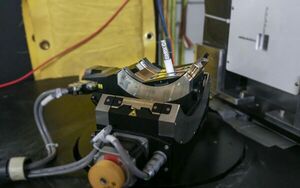
Automating neutron experiments with AI
"Oak Ridge National Laboratory researchers are developing a first-of-its-kind artificial intelligence device for neutron scattering called Hyperspectral Computed Tomography, or HyperCT. The fully automated, AI-driven platform can rotate a sample in almost any direction, eliminating the need for human intervention and significantly reducing lengthy experiment times. The design enables scientists using neutron scattering, a technique that measures atoms inside materials, to complete characterizations of samples without pauses for adjustments. The AI software determines the optimal angles to measure based on a sample’s shape, greatly reducing the amount of unnecessary data that could slow down experimental results. “With only a few input parameters, HyperCT will give us more accurate data roughly four times faster than conventional methods,” said ORNL’s Hassina Bilheux. Once developed, the technology can be used on any neutron scattering instrument, which will significantly increase the number of experiments and improve the quality of scientific data that only neutrons can provide." [...]

Samsung Electronics Publishes Paper in Nature Communications on Multifunctional Artificial Muscle Actuator
"Samsung Electronics’ Research in collaboration with Ajou University demonstrates the next-generation multifunctional artificial muscle actuator. Samsung Electronics today announced that Dr. Bongsu Shin (co-first author) at Samsung Research1 published a paper titled “Actuating Compact Wearable Augmented Reality Devices by Multifunctional Artificial Muscle” in the world-renowned journal ‘Nature Communications.’ This project was carried out in partnership with the Ajou University’s team of Mechanical Engineering, led by Professor Je-Sung Koh (corresponding author) based in Korea. The joint research team developed an artificial muscle actuator that can be applied on augmented reality (AR) glasses and naturally fit haptic gloves. With the increasing popularity of the metaverse, actuator and sensor technologies are evolving rapidly to create even more immersive experience in virtual worlds. Actuators and sensors integrated into wearable devices must be compact and lightweight as the devices are worn by users and often require mobility. The conventional actuator had certain limitations as to the realization of more advanced functionalities, as thin form factor and high-power density would be difficult for conventional types to achieve." [...]
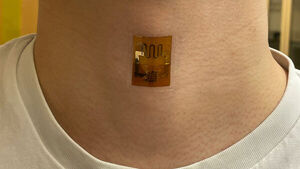
The bacteria powering a truly green revolution in personal electronics
"Researchers at the University of Massachusetts Amherst recently announced that they have figured out how to engineer a biofilm that harvests the energy in evaporation and converts it to electricity. This biofilm, which was announced in Nature Communications, has the potential to revolutionize the world of wearable electronics, powering everything from personal medical sensors to personal electronics. “This is a very exciting technology,” says Xiaomeng Liu, graduate student in electrical and computer engineering in UMass Amherst’s College of Engineering and the paper’s lead author. “It is real green energy, and unlike other so-called ‘green-energy’ sources, its production is totally green.” That’s because this biofilm—a thin sheet of bacterial cells about the thickness of a sheet of paper—is produced naturally by an engineered version of the bacteria Geobacter sulfurreducens. G. sulfurreducens is known to produce electricity and has been used previously in “microbial batteries” to power electrical devices. But such batteries require that G. sulfurreducens is properly cared for and fed a constant diet." [...]
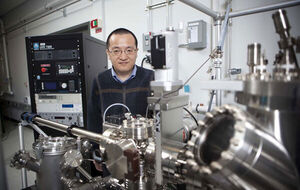
New Materials Research Sees Transformations at an Atomic Level
"When manufacturing techniques turn metals, ceramics or composites into a technologically useful form, understanding the mechanism of the phase transformation process is essential to shape the behavior of those high-performance materials. Seeing those transformations in real time is difficult, however. A new study in the journal Nature, led by Professor Guangwen Zhou from the Thomas J. Watson College of Engineering and Applied Science’s Department of Mechanical Engineering and the Materials Science program at Binghamton University, uses transmission electron microscopy (TEM) to peer into the oxide-to-metal transformation at the atomic level. Of particular interest are the mismatch dislocations that are ever-present at the interfaces in multiphase materials and play a key role in dictating structural and functional properties. Zhou’s students Xianhu Sun and Dongxiang Wu are the first co-authors of the paper (“Dislocation-induced stop-and-go kinetics of interfacial transformations”). Sun recently finished his PhD thesis, and Wu is a PhD candidate." [...]
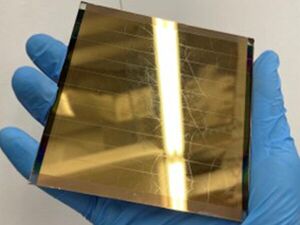
Nanoparticles increase light scattering, boost solar cell performance
"As demand for solar energy rises around the world, scientists are working to improve the performance of solar devices — important if the technology is to compete with traditional fuels. But researchers face theoretical limits on how efficient they can make solar cells. One method for pushing efficiency beyond those limits involves adding up-conversion nanoparticles to the materials used in the solar devices. Up-conversion materials allow solar cells to harvest energy from a wider spectrum of light than normally possible. A team of scientists testing this approach found the nanoparticles boosted efficiency, but not for the reason they expected. Their research may suggest a new path forward for developing more efficient solar devices." [...]

Researchers 3D print first high-performance nanostructured alloy that's both ultrastrong and ductile
"Researchers at the University of Massachusetts Amherst and the Georgia Institute of Technology has 3D printed a dual-phase, nanostructured high-entropy alloy that exceeds the strength and ductility of other state-of-the-art additively manufactured materials, which could lead to higher-performance components for applications in aerospace, medicine, energy and transportation. The work, led by Wen Chen, assistant professor of mechanical and industrial engineering at UMass, and Ting Zhu, professor of mechanical engineering at Georgia Tech, is published online by the journal Nature. Over the past 15 years, high entropy alloys (HEAs) have become increasingly popular as a new paradigm in materials science. Comprised of five or more elements in near-equal proportions, they offer the ability to create a near-infinite number of unique combinations for alloy design. Traditional alloys, such as brass, carbon steel, stainless steel and bronze, contain a primary element combined with one or more trace elements. Additive manufacturing, also called 3D printing, has recently emerged as a powerful approach to material development." [...]

New Stanford animation simulator focuses on finding interesting outcomes
"Simulators can jumpstart the work of animation, but often return an overwhelming array of options for the animator to sort through. A new browser refines those options to a more manageable number. Computer-based animators who are tasked with bringing to life imaginary worlds and characters are aided by simulators that can model the many possible ways an object or fluid might move through a physical space. Known as “solvers,” these simulators provide a significant head start on the work of animation. But there’s a catch. As computers have gotten faster, these solvers often create too many options for the animator to effectively sort through looking for just the right one." [...]

Researchers discover major roadblock in alleviating network congestion
"Algorithms designed to ensure multiple users share a network fairly can’t prevent some users from hogging all the bandwidth. When users want to send data over the internet faster than the network can handle, congestion can occur — the same way traffic congestion snarls the morning commute into a big city. Computers and devices that transmit data over the internet break the data down into smaller packets and use a special algorithm to decide how fast to send those packets. These congestion control algorithms seek to fully discover and utilize available network capacity while sharing it fairly with other users who may be sharing the same network. These algorithms try to minimize delay caused by data waiting in queues in the network. Over the past decade, researchers in industry and academia have developed several algorithms that attempt to achieve high rates while controlling delays." [...]

CDs to flexible biosensors: Researchers discover easy, inexpensive upcycling method
"Since 1999, more than 9 billion music CDs have shipped in the U.S. That’s not counting worldwide sales, DVDs, software discs or videogames. Sadly, discarded CDs end up in landfills with negative environmental consequences. New research from Binghamton University’s Thomas J. Watson College of Engineering and Applied Science offers a second life for CDs: Turn them into flexible biosensors that are inexpensive and easy to manufacture. In a paper published this month in Nature Communications, Matthew Brown, PhD ’22, and Assistant Professor Ahyeon Koh from the Department of Biomedical Engineering show how a gold CD’s thin metallic layer can be separated from the rigid plastic and fashioned into sensors to monitor electrical activity in human hearts and muscles as well as lactose, glucose, pH and oxygen levels. The sensors can communicate with a smartphone via Bluetooth. The fabrication is completed in 20 to 30 minutes without releasing toxic chemicals or needing expensive equipment, and it costs about $1.50 per device." [...]
Projetos Maker
Diversos Projetos interessantes.
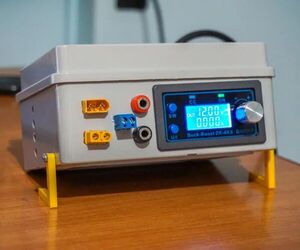
DIY Bench Variable Power Supply - ZK-4KX
"Hello to all boys and girls, today we will see together how I made a very compact DIY benchtop variable power supply that offers the possibility of adjusting the voltage, the current and has different types of inputs and outputs to be able to use it in the most versatile way possible. Supplies: - A 220V - 12V 5A transformer - A ZK-4KX Buck Boost converter module - 2X XT60 female connectors - 1X XT60 Male connector - 1X THT screw terminals - 3X red Banana connectors - 1X Black Banana Connector - 1X Panel mount fuse holder - 1X 5A Fuse - 1X Jack DC Female - 1X Electric bipolar switch - 1X Female IEC C14 with bipolar switch - 1X Integrated diode bridge - 2X Capacitors 2200µF - 1X Junction Box 110mm * 150mm * 70mm - 1x Cooling fan 80mm x 80mm" [...]

Slot machine game
"A simple and enjoyable slot machine. Story 1111 or 0000 to win this game. I am using a 5V ST7789 240*240 display that does not require a 5V to 3.3V converter. If you are using a 3.3V ST7789 240*240 display, please get a TXS0108E 8 channel converter. A0 of the Arduino Nano is the seed pin where the Nano will generate random numbers. D2 of the Nano is the push button signal pin." [...]

RC2014 Micro Keyboard reworked as PS/2
"Squeezing the full functionality of a computer out of just a 40 keys is a lot to ask for. Challenge accepted.. The people at rc2014.co.uk (read more here: https://rc2014.co.uk/history/) came up with this little Universal Micro Keyboard. It has the classic 8 x 5 matrix of the ZX81, ZX Spectrum, etc. and can be interfaced directly as a matrix keyboard. With the addition of an ATMEGA328P it can be hooked up as plain old serial or as USB (via FTDI)." [...]
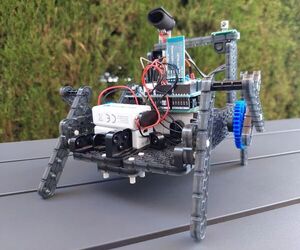
Different Ways to Control a Robot
"This project will show you three different ways to control a robot with an ARDUINO UNO board. The robot has been built with pieces and motors of a VEX robotics construction set with a shield and an ARDUINO UNO microcontroller board, sensors and leds. It can be controlled using: MIT App Inventor app with a bluetooth connection An IR remote controller A laser pointer The goal of this project is to show different programming templates for ARDUINO, you will be able to use to control your own devices. Supplies - VEX robotics construction set - ARDUINO UNO board - ARDUINO UNO shield - IR remote controller - Laser pointer - Mini breadboard - L293D chip - AT09 Bluetooth Low Energy module - IR receiver sensor - Laser receiver sensor - Buzzer - Leds - Two 9V rechargeable batteries - Wires" [...]
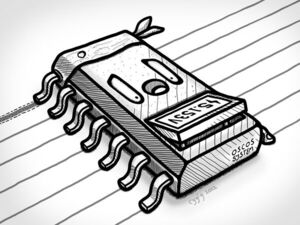
MCUVoltage
"MCUVoltage measures the voltage supply (Vcc) of Arduino without extra components. MCUVoltage measures the voltage supply (Vcc) of Arduino without extra components. Supported board includes Uno, Leonardo, Mega as well as the ATtiny3224/3226/3227. This library also supports oversampling and averaging. Hardware oversampling for the ATtiny3224/3226/3227 is also supported. Testing of ATtiny3224 is done on the megaTinyCore by SpenceKonde." [...]

Inexpensive Microphone amplifier circuit
"A small microphone amplifier circuit using operational amplifier in single power supply mode. Thinking a little bit on audio recording device, Mic section attracted my attention. In mobiles inbuilt amplifier is enough to record the sound via external microphone. That’s why no preamplifier required. But while recording with camera device this mic system is not provide enough gain and hence voice get distorted. So, we always use a microphone which has camera option." [...]
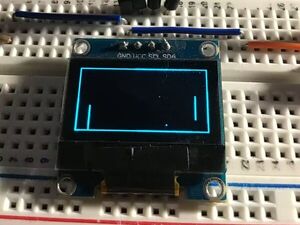
Oled 0.96 inch display Pong Game for arduino uno r3!
"My project is about a pong game on an 0.96 oled display useing the arduino uno r3 and 2 side buttons to control it! " [...]

Another Sound Level Meter Circuits
"This is the additional project for the Sound Level Meter (From hereafter as SLM) circuit making. I introduced the SLM prototype in the previous instructable as below. https://www.instructables.com/Sound-Level-Meter/ While working on the SLM prototype, I thought several improvements can be applied to make better SLM devices. Therefore, additional two SLM variants are made by applying the following improvements from the prototype. - Miniaturing the prototype to reduce the footprint of SLM to locate it anyplace near to the speaker - For better visual effect, changing LED types (Thick square type or highly bright small LEDs) - Dividing MIC/pre-amplifier from LM3915 display part to locate electrets MIC conveniently very near to the speaker I didn't change any circuit components (MIC, pre-amplifier, LM3915 display part) included in the prototype. These 2nd versions of SLMs are only changing shape, configuration, and assembling methods from the prototype." [...]
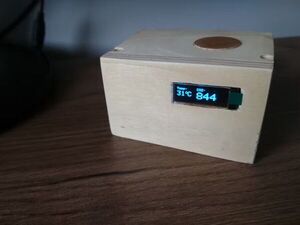
Watchdog of high CO2 levels
"Story I often work for hours in a close room so I got an idea to make my own appliance - my CO2 cube - to warn me if there are higher levels of CO2 in the room. Then it is the time to bring a fresh air in the room. My portable CO2 cube contains: - CCS811 sensor to measure the CO2 - pasive buzzer to make a sound if the CO2 level is high - KY-001 temperature sensor - OLED display 128x32 - push-button to show values on display - 3.7V battery from an old mobile - micro USB 5V Lithium Li-ion 18650 Battery Charger Module - switch to turn ON/OFF my CO2 cube The challenge of a portable arduino project is always about its consumption. To extend the battery life after charging there are following features: - the measurement is every 4th second, during this time we put arduino to sleep - we wake up CCS811 sensor only if we need a value from it, the rest time we put it to sleep - the brightness of the OLED display is reduced - if there are acceptable values of CO2, the OLED display is OFF, we can display values for a short time by pushing the button - if values of CO2 are higher, the OLED display starts to show them permanently and we are warned by the buzzer. By pushing the button we can turn off or turn on the OLED display Circuit The swith connects Arduino directly to the lithium battery to its 3.3V pin. All the components are connected to this 3.3V pin of Arduino." [...]

Simple clock with RGB indicator set using GPS
"This project started with an idea of making a simple clock for a child that just wants to know "should I get up yet". Problem description The project focuses on providing a simple clock, set by GPS, that gives the user a quick visual indicator (red / yellow / green) based on a defined schedule. The initial goal of the project was to create a clock for a child that would simply tell them if it was time to wake up or not. However, after I started working on the project my child said they also wanted to know what time it was so it still needed to function as a regular clock. Other Uses including Work from Home (WFH) Once the project was working, I realized it could be a "quick look" indicator for other purposes too. A solid use case would be work from home environments because it could 1) allow the person working to quickly see if they should be wrapping up soon (since it is easy to get caught up and lose track of time) and 2) allow family members, especially younger ones, to know if they can go talk to the person working." [...]

Bigtime Basement Build CNC for Laser and Wood Projects
"For this CNC build, I went after a laser, wood, and aluminum cutter/carver. Comparable units from reputable manufactures are over $2000. This one came in under $800. While I was at it, I made an Arduino Shield to simplify connections and developed new software for hobbyists to drive their custom CNC machines, called the Raising Awesome Carver. This Instructable is to show other enthusiasts how to design, build, and assemble such a thing - as well as offer insights to making your own GCode pusher to GRBL. I also share all my Autodesk 360 design files in case you want to modify for your own design." [...]

All Band Radio with New Firmware
"How to make a relatively simple All band DSP Radio Receiver with color touch display which is based on the Si47xx series chip This time I will return to one of my previous projects published a few months ago with the title: "DIY Si47xx All Band DSP Radio with 2.8 inch touch TFT display" (https://www.youtube.com/watch?v=q-D9nuZUE-Y&t=15s), which can also be obtained as a finished product under the name ATS-25 All Band Radio. And first of all, let me mention that the most deserving people for the development of this wonderful radio are: - Ricardo Caratti - PU2CLR - Gert Baak - PE0MGB - and Thiago - BD7JPY The reason for this post is a short presentation of the new firmware with which this small radio gets new improvements and functions, as well as option for a beautiful Retro look in the form of a mechanical scale for selecting stations. The new software was developed by "Harduino", and you can download Arduino Ide compatible version 4.0 on their forum (forum.harduino.ru). Mainly the improvements consist in Generally more stable operation, Touch screen sensitivity improved, Vertical screen operation, and other functions. - The entire menu has been made more functional and easier to operate. - The first thing that can be noticed on the start screen is more information about the current mode of operation." [...]

DIY Arduino Power Shield: Push Button On/off, Auto Shutoff, and External Watchdog Timer
"An Arduino shield is a circuit board with electrical components already permanently set up. This board is then plugged right into an Arduino board, making all the connections of the components fast and convenient, and error free. You can buy ready-made ones, but this one I made with discrete components soldered on a perf board. I designed it to add on to other Arduino projects, so it has many, many connection options, with the following features: - Pushbutton to power on - Programable pushbutton to shut off - Programable auto shutoff - External watchdog timer to reset the Arduino if it freezes - Optional ATtiny85 to control these functions, freeing the Arduino’s resources to handle other tasks Reason for starting this shield: In a data logging project with a battery-operated Arduino, I was recording to a microSD card. When I went to retrieve the data, the file was corrupted and all of my data was lost. This actually happened multiple times." [...]

IoT Automatic Dog Feeder
"We are going to build a simple IoT dog feeder that costs less than $30 and can be controlled remotely via an IoT software! Introduction Has your dog ever woke you up early in the morning for food? Do you blame yourself for not being able to feed your hungry pet because you are too busy and can’t get home on time? Purchasing a smart dog feeder that allows you to control it through the internet can be quite expensive. So why not design and build your own smart dog feeder with a few inexpensive electronic components? In this article, we are going to build a simple IoT dog (or other friendly creature) feeder that costs less than $30 and can be controlled remotely via an IoT software." [...]

Logic Game Using Digital Logic Gates
"Logic gates are an important concept if you are studying electronics. These are important digital devices that are mainly based on the Boolean function. Logic gates are used to carry out logical operations on single or multiple binary inputs and give one binary output. In simple terms, logic gates are the electronic circuits in a digital system. The logic gates that we are going to use in this project are: AND gate OR gate NOT gate AND Gate In AND gate the output of an AND gate attains the state 1 if and only if all the inputs are in state 1. If A=1 & B=1 then the output will be 1 otherwise, it will be zero OR Gate In OR gate the output of an OR gate attains the state 1 if one or more inputs attain the state 1." [...]
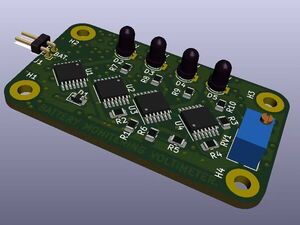
Car Battery Monitoring Voltmeter
"This project will design a car battery monitoring voltmeter that will help drivers monitor the conditions of their car batteries. Story The system has the main purpose of working as an indicator to the drivers of the vehicles on the battery life. It will indicate the voltages in the battery at a particular moment with an interval of 11V, 12V, 13V, and 14V. Although a voltmeter can be bought off-shelves, it is quite cheaper and interesting to build your circuit so that you can have the arrangement of the components in a compact manner and the way you would appreciate it. For the newbie, a voltmeter is an electronic or electromechanical device that is used to measure the potential difference between two given points of an AC or a DC source. In our system, the voltage will be measured by incorporating the voltmeter with the amount of charge that is available in the car battery." [...]

BilaSens GSM River Water Sensor
"This project starts in 2020 during pandemic lockdown, after that it have loong periods of dust collecting. Now is ready to start collect data and the code and the setup will be shared with the world! The setup is changed a lot during the two yers, in the first version i've imaged to record data on an SDcard as txt file and do not use any battery related precautions (a power bank that lasts some hours) then the second version saves data on sd card + via Bluetooth Serial (android app) the data will be transmitted to a mobile phone and then parsed in excel the latest version do not store data, but the readings are sent to thingspeak. with a RTC (real time clock on pin 2 as interrupt) the device exit from deepsleep every 6 hours. As environmental guide I work on a river (canoeing) and the curiosity to know some river's parameters is obviously great! This log is intended as self-learning work, if someone have some suggestion on my hobby-work feel free to comment!" [...]
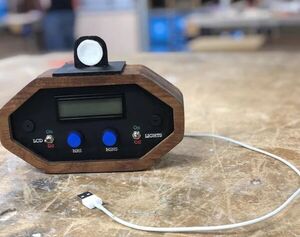
Arduino Alarm Clock & Apple Watch Charger
"In this tutorial, I will be walking you through the steps of building an Arduino alarm clock with an apple watch charger from scratch. Since I am building this from scratch, the process of building the housing for the circuit requires some machinery that cannot be found in everyday households (e.g Laser cutters, CNC machines, and 3D printers). That being said you can always still use the circuit and code while making your own housing for the product. I made this as a school project. Having already looked online for code and tutorials on how to make an alarm clock I found that once I followed all the steps, the clock never seemed to work, some seemed too complicated and others unfinished. As a result, I decided to try and code my own clock from scratch without using an RTC, This clock uses the millis() function instead." [...]
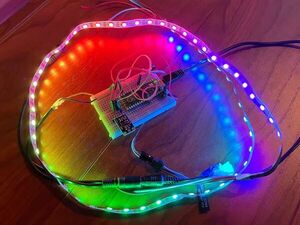
Voice-Activated LED Strip for $10: Pi Pico and Edge Impulse
"Build a voice-activated LED light strip controller on the cheap with Raspberry Pi Pico. LED light strips, sometimes called “Neopixels” in the maker community, are the perfect choice for interior lighting. They’re easy to install, inexpensive, and are completely programmable. Simply connect the light strips to a microcontroller, write some code to make whatever lighting pattern you want, and you’re good to go! Unfortunately for me, however, I’m lazy. I have no desire to get up and change the pattern if I get bored or turn it off if I want to go to bed." [...]
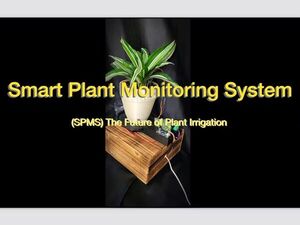
Smart Plant Monitoring System
"The Plant Monitoring System is an IOT product designed to provide climate/irritant readings to develop a sync & start smart irrigation sys. The idea for the Smart Plant Monitor was derived from Deep Dive Codings IOT bootcamp. The idea was to design a functional device that would sense irritants, climate, and moisture levels for the health and well being of a plant. A pot and stand were designed via 3D CAD modeling and printing. The device is setup for a Dracena Warnecki "Dragon Tree" plant that requires light in-direct sunlight and 1 watering a week with a moisture reading of less than 1800. The device will water the plant based upon those conditions." [...]
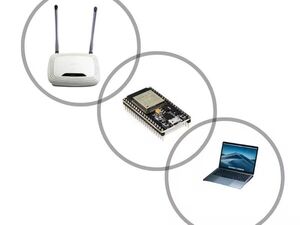
ESP8266 WiFi range extender Arduino
"Have you ever faced the problem of the WiFi not being able to reach to room? I have been there and that is why I built this WiFi extender. Story My mum has a portable WiFi device which is most time in her room, so the WiFi doesn't get to the living room and that's a problem but I love to solve problems so I did some googling and I found a GitHub repository for an ESP8266 repeater by martin-ger, the repo had a binary file for the repeater so I just flashed it into my esp8266 using esptool and it worked like magic. Click here to access the repository; however, there were some problems I had with this repeater(extender): - The web UI interface can't scan for WiFi networks so I don't know when I am in the range of the router unless I use the serial interface. - The web UI interface can't scan for WiFi networks so I don't know when I am in the range of the router unless I use the serial interface. - Debugging can be carried out by noting the rate at which the led is blinking, but there is a catch, the led state when it is connected to the router and when my phone connects to it as an access point is the same, so I get confused because I can't tell if is connected to the router or if my phone is connected to it." [...]

Electronic Googly Eye Glasses
"Build your own googly eye glasses or just attach the eyes to anything you want. Everything is better with googly eyes. Googly eyes never fail to make people smile and laugh where ever they unexpectedly show up. I first ordered some circular displays for another project but while testing them out I thought it would be fun to hook up an accelerometer and create a googly eye. After initial positive feedback, I decided to create googly eyes glasses so that I can wear googly eyes everywhere. This project teaches you how to build your own googly eye glasses." [...]

Analog Style Arduino OLED Clock
"This is a tutorial how to show you how to create analog style clock using Arduino and a small OLED display. There is also a video version of this tutorial. You will find the link at the end of this instructable. This project will show you that years after you finished education some stuff you learnt may be still usefull:) Trigonometry being one of them:) Enjoy. For this project we need just three components - Arduino Uno (you can use any other Arduino Board) - 128x64 I2C OLED display - DS1302 Real Time Clock (RTC) module" [...]
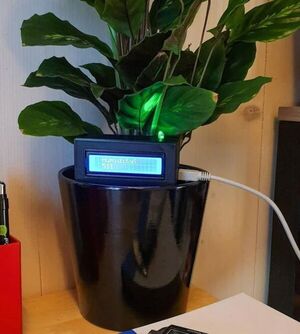
Build Your Own Plant Humidity Sensor
"Do you want to perfectionize your plants well being? Are you unsure how much water your plant needs? or do you just want to track how much water the plant consumes? Then this project is for you. Supplies Electronics: - Arduino Nano (any other microcontroller) - Arceli Water Level Sensor (alternatively: soil moisture sensor) - 16x2 QAPASS LCD - RGB LED Module - Cables/Wires - Power Cable (Mini USB type B to USB type A) Materials: - PLA Filament Tools: - CAD Software (Autodesk Fusion 360) - 3D Printer (Flashforge Adventurer 3) - 3D Print Slicer Software (FlashPrint) - Soldering Iron & Wire" [...]
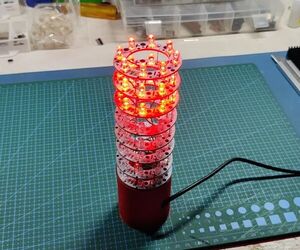
LED Tower V2
"Hey Everyone and what is up? So this is the LED TOWER 2.0 which is basically a fancy Desk Lamp made by combining LEDs in a row and lighting them up individually to make a pattern. 8 LEDs are connecting in parallel on a Ring PCB that has a mosfet as a switch setup to drive the LEDs, we add 8 more Rings together in a row with jumper wires to make a tower-like setup that looks super cool when lighten up. This Instructables is about the whole build process of this LED Tower, so let's get started. MATERIAL REQUIRED - Custom PCBs x 8 - 5mm RED LEDs x 64 - 3D Printed Base - AO3400 Mosfet - 10K Resistor 0603 - 12 Ohms 1206 - Jumper wires" [...]
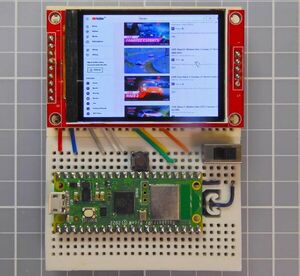
Playing Pico W With Arduino IDE
"This instructables show some projects you can play with your newly arrived Raspberry Pi Pico W with Arduino IDE. Note: There are much resources in Python platform that can be reused by Pico W but will not mentioned here. This instructables is mainly focus on Arduino IDE. Supplies - Raspberry Pi Pico W - A display module, e.g. ILI9341, ST7789... - breadboard and wires" [...]

Sound Level Meter
"This is a sound level meter circuit consisting of an electret condenser Mic, pre-amplifier circuit using NE5534/TL071 and LM3915 bar/dot display driver chip. According to the sound pressure captured by Mic, this device shows sound levels with LEDs. As the LM3915 requires predefined input voltage levels for correct operation, a pre-amplifier circuit is utilized for amplifying the weak Mic input signal. For dynamically displaying sound pressure levels with 10 LEDs, the LM3915 bar/dot display driver chip should be configured to support a certain input voltage range such as 60mV ~ 1.25V. I bought about 10EA of these chips quite a long time ago (Maybe more than 10 years ago!). Supposedly I had planned to make a battery capacity level meter or audio sound level meter with these chips." [...]
Satellite Tracker W/ Green Laser Pointer
"This an adaptation of Alex Changs Satellite Tracker. This a portable version and can be used with either stand alone post or it can be mounted on a tripod. This version incorporates is a sturdier platform in order to support a 5-10 mile green laser. Code includes a blinking LED to verify operation. Supplies: 1) 1 X Arduino MKR1000 2) 2 X Geared Stepper Motor 28BYJ-48 5V Stepper Motor + Uln2003 Motor w/ Ribbon 3) 1 X Green Long Range Astronomy Laser 4) 4 X 8x22x7 Skate Board Bearings 5) 2 X Urgenex 1000mah 2S1P Li-Po Battery 6) 1 X Generic 900mah 1S1P Li-Po Battery 7) 2 X 5cm 2-pin JST extension wires plug and socket male to female 8) 1 X 20cm JST PH 2.0 2-Pin Battery Male to Female Connector Extension Wire Cable 9) 4 X M3x8mm Socket Cap Head Bolts 10) 4 X M3 Nylon Locking Nut 11) 4 X M4x12mm Socket Cap Head Bolts 12) 4 X M4 Nylon Locking Nut 13) Rosin Soldering Flux 14) Activated Rosin Cored Wire Solder 15) Shrink Tubing 16) ABS Filament 17) 1/4oz Grey Lead Free Adhesive Backed Wheel Weights 18) 1 X #6x1/2” Pan Head Screw 19) 1 X #4x1/2” Pan Head Screw 20) 1 X Laser Safety Glasses 21) Acetone (optional). 22) Wi-Fi Access" [...]
Secção Videos
Videos interessantes.
That's all Folks!




